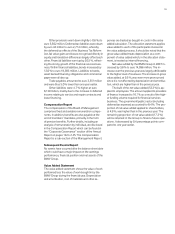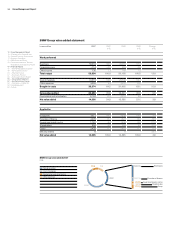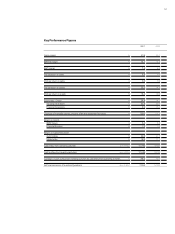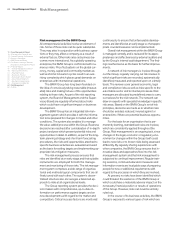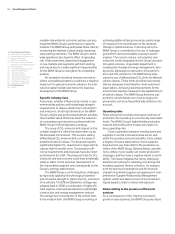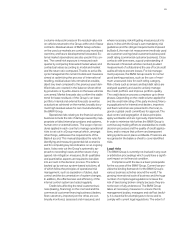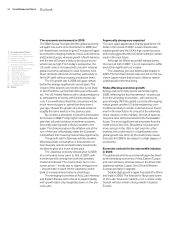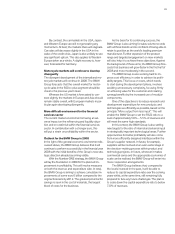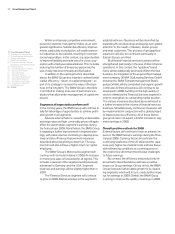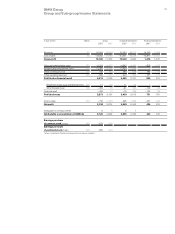BMW 2007 Annual Report Download - page 66
Download and view the complete annual report
Please find page 66 of the 2007 BMW annual report below. You can navigate through the pages in the report by either clicking on the pages listed below, or by using the keyword search tool below to find specific information within the annual report.64 Group Management Report
10 Group Management Report
10 A Review of the Financial Year
13 General Economic Environment
17 Review of Operations
41 BMW Stock and Bonds
44 Disclosures relating to Takeover
Regulations and Explanatory Report
47 Financial Analysis
47 – Internal Management System
49 – Earnings Performance
51 – Financial Position
52 – Net Assets Position
55 – Subsequent Events Report
55 – Value Added Statement
57 – Key Performance Figures
58 – Comments on BMW AG
62 Risk Management
68 Outlook
seeable interventionist economic policies can also
impair the BMW Group’s performance in specific
markets. The BMW Group anticipates these risks by
monitoring the markets in detail and by observing
early warning indicators. The BMW Group’s world-
wide operations also have the effect of spreading
risk. At the same time, determined engagement
in new markets and segments with both existing
and new products creates significant opportunities
for the BMW Group to strengthen its competitive
position.
An escalation of political tensions, terrorist ac-
tivities or possible pandemics could have a negative
impact on the general economic situation, the inter-
national capital markets and hence the business
development of the BMW Group.
Specific industry risks
Fuel prices, whether influenced by market or gov-
ernmental tax policies, and increasingly stringent
requirements to reduce vehicle fuel consumption
and emissions, all set high demands on the BMW
Group’s engine and product development activities.
One manifest result of this has been the reduction
of consumption and emissions achieved with the
BMW Group’s EfficientDynamics strategy.
The issue of CO2 emission limits based on the
unladen weight of a vehicle has been taken up by
the European Commission. This involves setting
differentiated CO2 emission limits on the basis of
predefined vehicle classes. The proposal requires
significantly higher CO2 reductions for larger vehicle
classes than for smaller ones. Consumption effi-
ciency requirements and proposals have also been
put forward in the USA. The proposed rules for CO2
emissions and fuel economy could have a materially
adverse effect on the business development of
the Automobiles segment and consequently on the
Group’s earnings performance.
The BMW Group is confronting these challenges
by rigorously applying its technological expertise
and innovative strength to reduce the CO2 emissions
of its vehicles. The EfficientDynamics strategy was
adopted back in 2000: a combination of highly effi-
cient engines, improved aerodynamics, lightweight
construction and energy management reduces
the average fuel consumption of the vehicle fleet.
In the medium term, the BMW Group is working on
achieving additional fuel economy by a wide range
of measures from electrification of the drivetrain
through to hybrid solutions. In the long-term, the
BMW Group is committed to the use of hydrogen
gained from various renewable sources to power
engines. The need to reduce consumption and
emissions is fully integrated into the Group’s product
innovation process. A specialist department is
studying the interplay of energy management, aero-
dynamics, lightweight construction, drive perform-
ance and CO2 emissions. The BMW Group advo-
cates the use of differentiated CO2 limits for different
vehicle classes. These limits should be set at levels
that are transparent and therefore meet customers’
expectations. Achieving real improvements for the
environment requires measures to be applied fairly to
all vehicle classes. The BMW Group therefore sup-
ports the current debate as to how ecological im-
provements can be achieved that take all factors into
account.
Operating risks
Risks arising from business interruption and loss of
production are insured up to economically reasonable
levels. The BMW Group’s highly flexible production
network and working time models also help to re-
duce operating risks.
Close cooperation between manufacturers and
suppliers is normal in the automotive sector, and
whilst this provides economic benefits, it also creates
a degree of mutual dependence. Some suppliers
have become very important for the production ac-
tivities of the BMW Group. Delivery delays, cancella-
tions, strikes or poor quality can lead to production
stoppages, and thus have a negative impact on profit-
ability.
The Group mitigates this risk by employing
extensive procedures for selecting, monitoring and
handling suppliers. Before selection, for example,
both the technical competence and the financial
strength of potential suppliers are appraised. A com-
prehensive Supplier Relationship Management
system, which also takes account of social and eco-
logical aspects, helps to reduce risk exposure.
Risks relating to the provision of financial
services
As a consequence of the ongoing successful
growth in lease business, the BMW Group also faces



